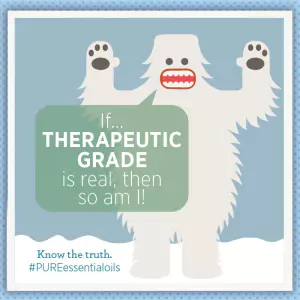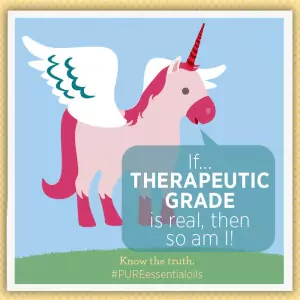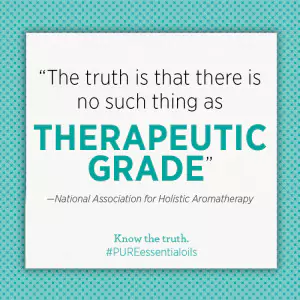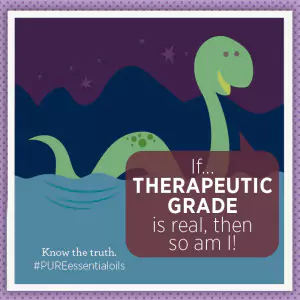Essential Oils and the “Therapeutic Grade” Myth

The launch of PURE™ Essential Oils at Convention 2015 in May was met with tremendous enthusiasm, and Melaleuca has been absolutely thrilled with the phenomenal customer response. Tens of thousands of customers, many of whom were already familiar with and using essential oils, are now enjoying the uncompromising purity, guaranteed quality, and aromatic excellence of PURE Essential Oils.
While the use of essential oils is commonplace for many people, others are new to the experience. It stands to reason that customers would have questions about essential oils: What are they exactly? Where do they come from? What are their benefits? How are they used? Since May, Melaleuca has fielded numerous questions like these.
One of the most common questions customers have asked, is whether or not Melaleuca’s essential oils are “therapeutic grade.” Others have heard the term “therapeutic grade” and want to know what it means.

The term “therapeutic grade” sounds technical, official, and impressive, as if it were an industry-recognized certification reserved only for the highest-quality essential oils. If that were the case, and this term was in fact used to grade essential oils, then Melaleuca PURE Essential Oils—which are 100% pure—would easily qualify for the distinction.
The problem is that the term “therapeutic grade” and another like it, “CPTG Certified Pure Therapeutic Grade,” are nothing but marketing ploys. They were made-up by essential oil companies to help sell their own products.
Differentiating one product from another is a critical aspect of marketing. However, there are times when this differentiation is a “certification” fabricated in an attempt to elevate a product as the market’s “gold standard.” This was the tactic used in 2007 to create the term “therapeutic grade.”

Prior to 2007, the term “therapeutic grade” did not exist in the essential oil market. This term is not an independent or third party endorsement of purity and quality, but a trademarked marketing term created by a company selling essential oils. This 2007 creation spurred a greater fallacy, the term “CPTG Certified Pure Therapeutic Grade.” Again, this term sounds technical, implying the product has been “certified” to be pure and of therapeutic grade. But, like its predecessor, it is nothing more than a made up, trademarked phrase.
What’s more, these fabricated terms are defined by the very companies who invented them. Where there should be consistency, “therapeutic grade” seems to have different definitions. For example, some sources list as many as seven tests to determine “therapeutic grade,” while other sources list only two tests for the same “certification.”
Currently, there is no governing body that certifies essential oil quality and production, or designates a standardized grading system for essential oils. Making up terms like “therapeutic grade” and “CPTG Certified Pure Therapeutic Grade” implies that there is such a controlling entity, and Melaleuca believes that this practice is deceitful and unethical.
To put it succinctly, these terms have no real certification or quality value. They are complete myths.
That being said, Melaleuca is committed to ensuring that PURE Essential Oils are always the highest quality, purist oils available on the market. In the absence of a central governing body, we rely on two entities that provide reputable quality specifications for many essential oils: the Association Française de Normalisation (AFNOR) and the International Organization for Standardization (ISO). In the event that there is no AFNOR or ISO standard upon which to grade our essential oils, we compare them to historical testing data from essential oils experts.
There are other terms used to describe the quality of some essential oils. These terms include “medicinal grade” and “aromatherapy grade.” Again, they do not have any actual certification value.

Until there is a government agency or other official body that certifies or “grades” essential oils, the best and easiest way to determine the purity of any oil is to look at the label on the bottle. Melaleuca’s PURE Essential Oils are labeled as 100% pure. (That should tell you all you need to know, as nothing can be purer than 100%.) Each oil is certified not to contain any impurities or synthetic ingredients.
The other thing to keep in mind when it comes to essential oils, is that purity and quality are two different things. Just because something is pure doesn’t mean it is high quality. Look at it this way: How would you like a glass of 100% pure orange juice…squeezed from unripe, sour oranges?
PURE Essential Oils are also rigorously tested to meet stringent quality specifications. They undergo a battery of seven different quality tests to ensure they are always the highest quality available:
- Chirality testing
- Gas Chromatography/Mass Spectrometry (GCMS) testing
- Heavy metal/pesticide/herbicide testing
- Microbial testing
- Optical rotation and refractive index testing
- Organoleptic testing
- Specific gravity testing
In addition, each PURE Essential Oil is harvested through ethical and sustainable practices and traceable to its botanical plant source. The result is a line of essential oils of the highest standards.
If you have any additional questions about PURE Essential Oils, please refer to the Essential Oils FAQ page.

Thank you for that clarification and for being a company of quality and integrity
I am interested in knowing how many PURE Essential Oils Melaleuca carries.
Thank you
thank you for this helpful information
Thank you for this much needed article! I have people who have had connections with other essential oil companies and this will bring education and confidence!
Excellent information. I love the Lavender oil and putting a few drops on the pillow helps me to sleep well!
I just received the Aromatherapy and Essential Oils book that was recommended by Melaleuca. On page 174 there is a recipe for Monster Spray…so, when I saw this presentation on my Instagram this morning…just a perfect fit!!! Thanks for all you do…
Melaleuca carries PURE Essential Oils …
25 Single Oils
2 Carrier Oils
5 Blends
Pure Ultrasonic Humidifier and much More
Dalil
I always trust Melaleuca to only provide the best of everything~
Thanks Melaleuca ! So important to use the correct language. Proud to be a part of such an ethical company. Love the graphics too!
Thanks for sharing and clarifying! This line has added a whole new avenue of possibilities!
Spanish please.
How do I get a copy of the Aromatherapy and Essential Oils book recommended by Melaleuca? I am very interested in all the oils. I have tried Vapor in the diffuser for bronchitis and Lavender at bedtime. Very excited to enter the oil therapy world.
What book did they recommend? I can’t seem to find that anywhere.
I am 76 years old and have a lot of health problems. Would like to learn more about essential oils to help.
I was never into oils but would love to learn more about their proper uses.
What book was recommended?
What is the book that was recommended?
Thank you for the clarification and confidence that the PURE Essential oils line is, like all the other products, such high quality.
I have had a lot of customer interest and those “Therapeutic Grade” terms have been thrown around quite a bit.
May I have the exact name and author of the book that Melaleuca recommends? Thanks!
I want to know where I can find the Essential Oils book…..
Would like to know what the difference is besides prices between Melaleuca and Young Living oils? ??
Thanks! Am anxious to hear your point of view!
Do you have oils that contain any nuts ? or any kind of nuts added to them cause i have a nut allergy ?
essential oils come from plants, not nuts. so no worries.
essential oils are derived from plants. no nuts. so no worries.
I would like to know the name of the book and where I can purchase it.
Several of you are asking about this book. I called Melaleuca’s product question line (800-742-8094), and Melaleuca does recommend a book.
They tell you about this in the July LIA Pg. 45. You can purchase this at Amazon..com It’s $19.00. Complete Aromatherapy & Essential Oil Handbook for Everyday Wellness
by Nerys Purchon (Author), Lora Cantele (Author)
Except for the carrier almond oil. But you can always use the coconut oil as carrier instead.
Are the oils Melaleuca sells ingestible? Not all oils are ingestible!
Internal usage of essential oils is not necessary to achieve therapeutic benefits, in fact more often then not the risks outweigh the benefits. Inhalation/diffusing and properly diluted topical application are fabulous! Great insight from the National Association of Holistic Aromatherapy here: https://www.naha.org/explore-aromatherapy/safety/naha-safety-statements/
I have many friends involved with DoTerra, the number one essential oils company. At an essential oils class tonight I brought my melaleuca essential oils. One of the differences pointed out is that DoTerras oils are ingestible, and melaleucas are not. If melaleucas essential oils are truly pure, then why are they labeled for external use only? This concerns me, and may affect whether I continue to purchase essential oils through melaleuca. Please explain.
I would love to know the answer as well. I have been trying to figure out the difference between Melaleuca and all the other essential oil companies.
Ingesting ANY brand of essential oil is risky. Too much of a good thing is bad; and ingesting essential oils (the oils being a VERY concentrated good thing) is a sure way to over-do it. If you choose to ingest oils, do so very sparingly. Topical use and applying to the bottom on one’s feet are a QUICK, painless, and tasteless way to obsorbe the benefits of all essential oils.